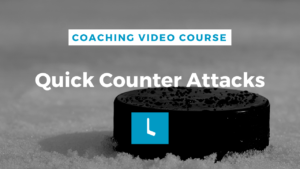In this section, we will be discussing ‘Transitions and Counter Attack’ once our team has regained possession of the puck. In this section, we will explore reading pressure in the neutral zone. The puck retrieving D1 often or F1 is either going to have no pressure, some pressure or tight pressure.
With no pressure..
- The other team has chipped or dumped the puck out it out of their defensive zone.
- We want to get that puck in the neutral zone and get back in their defensive zone as quickly as possible.
- Limiting the time we spend in the neutral zone is very important.
- Typically that might be a deep puck retrieval, giving it right away to our W’s or to the C and away we go back into their zone.
Under some pressure…
- It’s a great idea to try to use the D.
- Let’s say the puck is just outside the opposing teams blue line and our F1 has come out and retrieved it and our D1 has backed up.
- Important fact is that the D1 strong side is supporting a little tighter and D2 is staggered or hinged off of D1, so when we go D to D it’s a bit of a back pass to create space.
- Rather than turning around back into the pressure once F1 has the puck we want to use a pass to D1 then a quick D to D to get the puck to the weak side D2.
Now we have more options. We stretched out their forecheck and we can go back up the middle or right up to the new strong side FWD on the wall. This is also one of those cases where the weak side FWD, might want to stretch just as he/she could have in the defensive zone. So now this is a longer pass and we’ve moved the puck with pressure coming from the other side, kind of around the horn like you see in soccer a lot. From D to D up to the new strong side FWD. And the middle lane FWD supports, and we go back into the zone.
Under tight pressure…
This would happen if a play breaks up and most players from either team are inside. We have tight pressure on us and it develops basically into a battle along the wall.
- F1 may need to eat this puck which means just keep it on the wall and wait for something to develop, wait for some help from F2 or that’s when we chip it forward.
- I don’t like to chip it forward if we don’t fully have to, it’s more of a last resort option. So we do need some form of patience here to see if anything can develop and hockey sense to recognize as well.
- If we eat it and have patience for the secondary support to come retrieve the puck, then we make that pass to D1 once available.
- Now we have got from tight pressure to some pressure.
- Then we make that D to D and we are back to no pressure.
- Once weak side D2 has the puck they have three options, skate it, pass to the FWD on the wall or hit the F2 who is now cutting in the middle lane with a pass.
Key factor: spend as little time between the blue lines as possible. Use the width of the ice on the weak side. Eat it, hang on to it when you must. Either chip it forward and go attack or if you have an opportunity to move it to an open area.
That’s how we read pressure when in the neutral zone! See you in the section!
(Transcribed from How to Play Hockey: Our Minor Hockey Coaching Course.)
Looking to download half ice hockey practice plans, goalie drills for teams (not a goalie coach?!) or small area games drills? We’ve got you covered too. Click here. Perfect for recreational level coaches.






